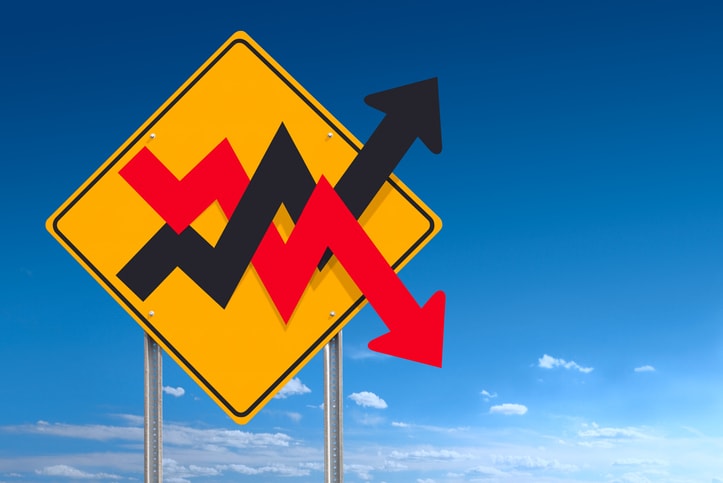Like most things in life, markets tend to move in cycles: Asset prices rise and fall and then rise again over time. Understanding how these cycles work and the phases involved can help investors decide when to buy, hold and sell. Let’s take a look at the phases of the market and how they impact investors.

What is a market cycle?
A market cycle occurs in the period between the most recent high point and low point of a market or index. These can last anywhere from a few hours to decades, depending on the asset class involved. In stock markets, a full cycle tends to last several years at least (and often much longer) though it duration and intensity is ultimately determined by market circumstances and sentiment.
The four phases of a market cycle
The conventional belief is that a cycle has four identifiable phases:
1. Accumulation phase
This phase occurs after the market has bottomed out and corporate insiders, value investors and smart money managers begin buying so-called risk-on assets like stocks again. Most money/investors, however, remain on the sidelines and many burnt by the recent bear market sell out of stocks completely. Negative headlines continue to dominant the news – focusing on the effects of the bear market and weaknesses in the economy. Demand for safe haven assets like gold, bonds or cash remain high, though begins to decline as the phase continues. Overall sentiment, however, gradually shifts from negative to neutral as the phase goes on.
This phase often begins before a turnaround in the economy gets underway – for instance the US stock market reached its post-crisis low in March 2009, though the economy would remain in recession for the remainder of that year. The gains during the period can be significant – the benchmark Dow Jones Industrial Average (DJIA) gained more than 20% in the space of three weeks after that low.
2. Mark-up phase
Once the market has begun its move higher, more traders and investors return. Money gradually starts to flow away from safe haven assets and back towards stocks. Technical charts show the market posting higher lows and highs and news headlines start to report on the recent improvements and there is growing talk about whether or not the economy has turned a corner. Overall, there is a growing recognition that the market’s direction has changed.
As this phase goes on, more money enters the market and volumes increase. Valuations begin to climb above historical norms and euphoria begins to take hold. News organisations talk about the booming stock market and speculation turns to how far the bull run can go.
3. Distribution phase
In this phase, sellers begin to dominate. The bullish sentiment of the mark-up phase gives way to a more mixed sentiment where traders and investors become increasingly divided over where the market is headed.
For much of this period the market will trade more or less sideways, failing to rally past recent highs but not yet reversing direction. Historically, this phase can last anywhere from a few weeks after a market peak to well over a year.
When the distribution phase is over, the market will begin to reverse. Investor sentiment will turn negative and money will start to shift away from stock markets and towards stocks, bonds and cash.
4. Mark-down phase
In the final phase, panic takes control. Stock prices plummet while safe haven assets soar to new highs. Many investors hang on in the hope the market will turn only to eventually give up and cut their losses towards the end of the phase – shortly before the clued-in money managers and value investors start to re-enter.
The losses in this phase are significant and can be very painful for the people involved. For example, the DJIA lost more than 54% between its high in pre-crisis high in 2007 and its 2009 low.
How does the market cycle affect long-term investors?
The market cycle can clearly have a huge impact on investor returns. A person who buys in to a market during the accumulation phase and sells out during the distribution phase will have done very well while someone who buys during the distribution phase and sells out late in the mark down phase will have likely lost a lot of money.
But what about longer term investors? The ones who stay invested, more or less, across not only one cycle but many? Pretty well, is the answer: Someone who invested $10,000 across the Dow Jones Industrial Average index in 1985 would have more than $275,000 today, assuming they made no further contributions. That’s an annualised return of more than 10% despite weathering the 1987 crash, the tech bubble, the financial crisis of 07-09 and numerous corrections.
Has the low interest rate environment warped the market cycle?
After a ten-year bull market in the US – the longest in history – many market watchers believe the market cycle has become distorted through the actions of central banks. Globally, interest rates are at all-time lows a decade after the global financial crisis, which makes it cheaper to borrow money and means there is limited incentive to hold cash as an asset. Meanwhile, quantitative easing programs in the US and Europe have also pushed bond yields to record lows which, almost paradoxically, means that demand for a well-known safe haven asset has soared alongside risk-on assets like stocks, throwing one aspect of the traditional market cycle dynamic out the window for the time being.
However, at some point the current bull market will end and it’s likely the conventional market cycle will eventually return.
Learn more about investing in low interest environments.
